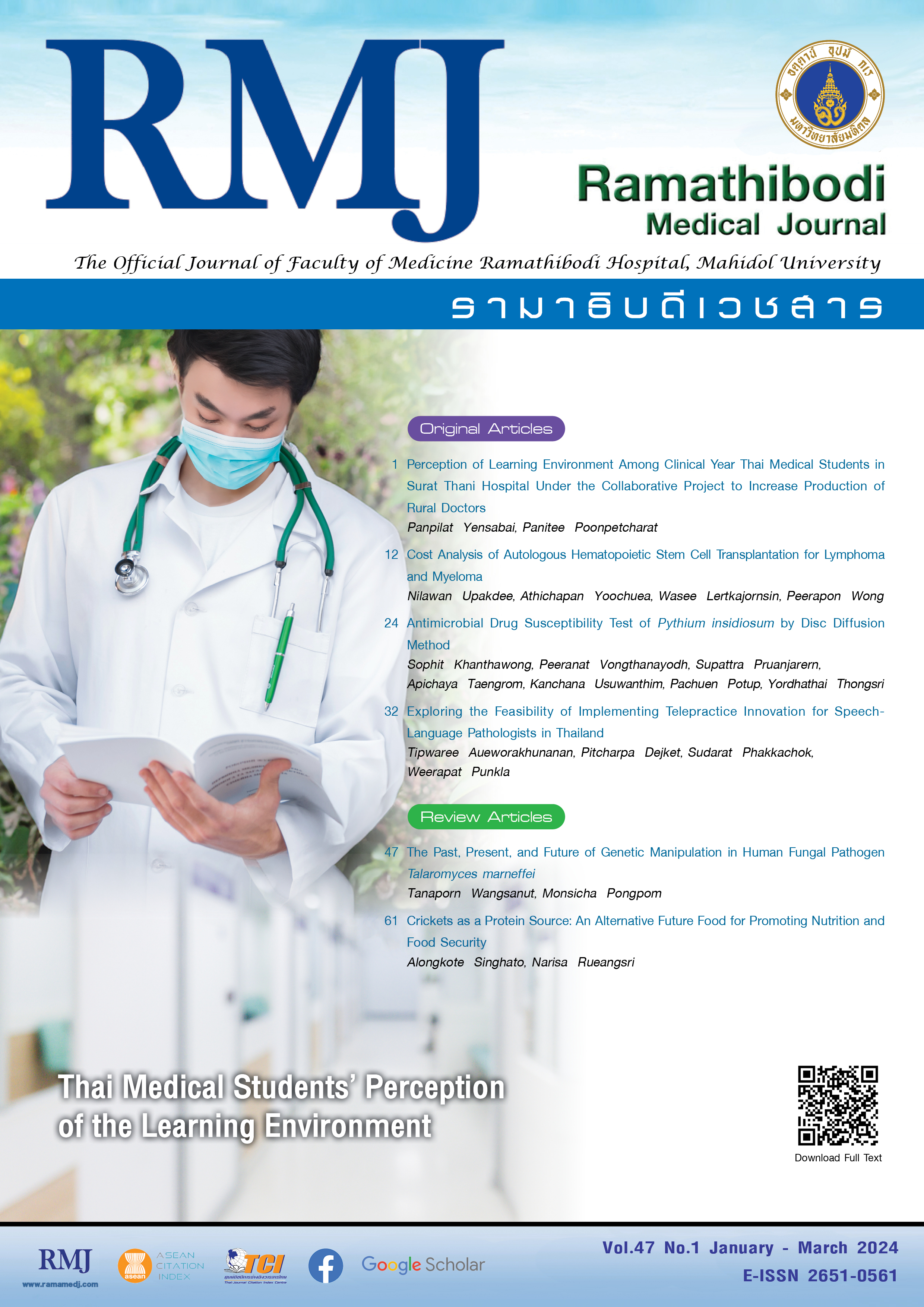Antimicrobial Drug Susceptibility Test of Pythium insidiosum by Disc Diffusion Method
DOI:
https://doi.org/10.33165/rmj.2024.47.1.267191Keywords:
Pythium insidiosum, Pythiosis, Antimicrobial drugAbstract
Background: Pythiosis is a life-threatening disease caused by the fungus-like organism Pythium insidiosum. It causes disease in both animals and humans. Amphotericin B antifungal is less effective because it lacks ergosterol, a drug target in the cell membrane.
Objective: To evaluate antimicrobial susceptibility test of P. insidiosum isolated from human pythiosis by disc diffusion method.
Methods: The antimicrobial drug susceptibility test by disc diffusion method was tested against 10 clinical isolated strains of P. insidiosum. Antimicrobial drugs comprise of 8 antibiotics (chloramphenicol, cefotaxime, ciprofloxacin, gentamycin, tetracycline, meropenem, oxacillin, and vancomycin) and 2 antifungal drugs (itraconazole and amphotericin B) which were included in the test.
Results: Antimicrobial drugs susceptibility tests were performed on 10 clinically isolated strains of P. insidiosum. Six of them showed susceptibility to antimicrobial drugs. The cutaneous pythiosis strain (SIMI 8569) showed the highest number of susceptibilities to antimicrobial agents (chloramphenicol, ciprofloxacin, gentamycin, tetracycline, vancomycin, and itraconazole). In addition, 4 strains of P. insidiosum (M 29, SIMI 6666, SIMI 7873, and SIMI 2989-42) were not inhibited by all antimicrobial drugs.
Conclusions: This result concluded that chloramphenicol, tetracycline, and itraconazole inhibited the mycelial growth of P. insidiosum better than the other drugs. The inhibition effects of these drugs were observed in 40% - 60% of the strains. Further experiments should be carried out to evaluate the tested drugs in various concentrations with other more susceptible methods to get more precise concentrations exposed to P. insidiosum isolates such as broth dilution or dilution assays.
References
Gaastra W, Lipman LJ, De Cock AW, et al. Pythium insidiosum: an overview. Vet Microbiol. 2010;146(1-2):1-16. doi:10.1016/ j.vetmic.2010.07.019
Mar Htun Z, Laikul A, Pathomsakulwong W, et al. Identification and biotyping of Pythium insidiosum isolated from urban and rural areas of Thailand by Multiplex PCR, DNA barcode, and proteomic analyses. J Fungi (Basel). 2021;7(4):242.doi:10.3390/jof7040242
Vanittanakom N, Szekely J, Khanthawong S, Sawutdeechaikul P, Vanittanakom P, Fisher MC. Molecular detection of Pythium insidiosum from soil in Thai agricultural areas. Int J Med Microbiol. 2014;304(3-4):321-326. doi:10.1016/j.ijmm.2013.11.016
Mendoza L, Hernandez F, Ajello L. Life cycle of the human and animal oomycete pathogen Pythium insidiosum. J Clin Microbiol. 1993;31(11):2967-2973. doi:10.1128/jcm.31.11.2967-2973.1993
Krajaejun T, Sathapatayavongs B, Pracharktam R, et al. Clinical and epidemiological analyses of human pythiosis in Thailand. Clin Infect Dis. 2006;43(5):569-576. doi:10.1086/506353
Lerksuthirat T, Sangcakul A, Lohnoo T, Yingyong W, Rujirawat T, Krajaejun T. Evolution of the sterol biosynthetic pathway of Pythium insidiosum and related oomycetes contributes to antifungal drug resistance. Antimicrob Agents Chemother. 2017;61(4):e02352-16. doi:10.1128/AAC.02352-16
Yolanda H, Krajaejun T. Review of methods and antimicrobial agents for susceptibility testing against Pythium insidiosum. Heliyon. 2020;6(4):e03737. doi:10.1016/j.heliyon.2020.e03737
Susaengrat N, Torvorapanit P, Plongla R, et al. Adjunctive antibacterial agents as a salvage therapy in relapsed vascular pythiosis patients. Int J Infect Dis. 2019;88:27-30. doi:10.1016/j.ijid.2019.08.032
Argenta JS, Alves SH, Silveira F, et al. In vitro and in vivo susceptibility of two-drug and three-drug combinations of terbinafine, itraconazole, caspofungin, ibuprofen and fluvastatin against Pythium insidiosum. Vet Microbiol. 2012;157(1-2):137-142. doi:10.1016/j.vetmic.2011.12.003
Cavalheiro AS, Maboni G, de Azevedo MI, et al. In vitro activity of terbinafine combined with caspofungin and azoles against Pythium insidiosum. Antimicrob Agents Chemother. 2009;53(5):2136-2138. doi:10.1128/AAC.01506-08
Shenep JL, English BK, Kaufman L, et al. Successful medical therapy for deeply invasive facial infection due to Pythium insidiosum in a child. Clin Infect Dis. 1998;27(6):1388-1393. doi:10.1086/515042
Permpalung N, Worasilchai N, Plongla R, et al. Treatment outcomes of surgery, antifungal herapy and immunotherapy in ocular and vascular human pythiosis: a retrospective study of 18 patients. J Antimicrob Chemother. 2015;70(6):1885-1892. doi:10.1093/jac/dkv008
Thongsri Y, Wonglakorn L, Chaiprasert A, et al. Evaluation for the clinical diagnosis of Pythium insidiosum using a single-tube nested PCR. Mycopathologia. 2013; 176(5-6):369-376. doi:10.1007/s11046-013-9695-3
Worasilchai N, Chindamporn A, Plongla R, et al. In vitro susceptibility of Thai Pythium insidiosum isolates to antibacterial agents. Antimicrob Agents Chemother. 2020;64(4): e02099-19. doi:10.1128/AAC.02099-19
Maeno S, Oie Y, Sunada A, et al. Successful medical management of Pythium insidiosum keratitis using a combination of minocycline, linezolid, and chloramphenicol. Am J Ophthalmol Case Rep. 2019;15:100498. doi:10.1016/j.ajoc.2019.100498
Medhasi S, Chindamporn A, Worasilchai N. A review: antimicrobial therapy for human pythiosis. Antibiotics (Basel). 2022;11(4):450. doi:10.3390/antibiotics11040450
Brown TA, Grooters AM, Hosgood GL. In vitro susceptibility of Pythium insidiosum and a Lagenidium sp to itraconazole, posaconazole, voriconazole, terbinafine, caspofungin, and mefenoxam. Am J Vet Res. 2008;69(11):1463-1468. doi:10.2460/ajvr.69.11.1463
Downloads
Published
How to Cite
Issue
Section
License
Copyright (c) 2024 Ramathibodi Medical Journal

This work is licensed under a Creative Commons Attribution-NonCommercial-NoDerivatives 4.0 International License.

















